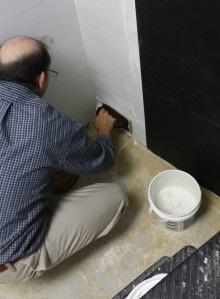Archive for category Animal Shelters
DIY – Treating a Wall – BlockAid® and SoundChannels®
Posted by Acoustics First in Absorption, Animal Shelters, Auditorium, Broadcast Facilities, Classrooms, DIY, Fitness, Government, Gymnasium, Home Entertainment, Home Theater, HOW TO, Media Room, Multipurpose Rooms, Music Rehearsal Spaces, Music Tracking Room, Product Applications, Recording Facilities, Recording Studio, School & Educational Facilities, Sound proofing, Studio Control Room, Teaching Rooms, Teleconferencing, Theater, Uncategorized, Vocal Booth, Voice Over on July 16, 2015
 On many occasions, we get asked about common ways to treat a wall (or walls) either for broadcast, podcast, or other voice recording scenario – where they not only want to tame the reflections within the room, but also block a certain amount of sound coming into – or leaving the room.
On many occasions, we get asked about common ways to treat a wall (or walls) either for broadcast, podcast, or other voice recording scenario – where they not only want to tame the reflections within the room, but also block a certain amount of sound coming into – or leaving the room.
Budget is frequently an issue, major construction is usually unwanted, but effective results are always required.
We’re going to show you how to handle a room upgrade – cut down on the sound transmission and cut the room reflections – all with the same skills required to hang high quality wall coverings! Let’s see how you can cover a wall with BlockAid® vinyl sound barrier to block unwanted sound, then go back and cover that with an absorptive layer of Sound Channels® wall covering to finish it off!
This treatment is not recommended for renters, as this is not an easy upgrade to undo. However, if you have an extra bedroom you are using as Podcast studio, this is a great way to treat it… Let’s get started!
Installing BlockAid®
Good job! Now, take a breather while that dries, and notice how much less sound is passing through the walls. This is when you will notice that the sounds are now coming from under the door, and through the leaky old window. These can be taken care of in different ways…. but the easiest way is the same way you deal with keeping the cold out! Get some weather strip, a door skirt, seal the gaps around the frame of the door, and windows, maybe go out and buy some heavy curtains for the windows… if you have some leftover BlockAid®, you can always get some Industrial Velcro and temporarily stick a piece over the window!
Installing Sound Channels®
That’s it!
This treatment is a common first step in treating many professional broadcast studios – it gives you extra isolation with the barrier and takes the edge of the sound reflections. Many professional environments then go back and add some additional treatments such as bass traps, diffusers, and broadband absorber panels – especially if these studios are planning on bringing in any musical guests.
This isn’t just for home studios. It works great for kids play rooms, bedrooms, home theaters, home gyms, and any place you want to block sound and tame the sound inside the room.
Customize your space as you will, but this treatment is a consistent winner for cost and performance, and is a great way to get started without breaking the bank!
Baffled by Acoustical Ceiling Treatments?
Posted by Acoustics First in Animal Shelters, Art Galleries, Auditorium, Construction Sites, Fitness, Gymnasium, Industrial Facilities, Multipurpose Rooms, Museums, Press Release, Products, Restaurants, School & Educational Facilities, Theater, Universities, Worship Facilities on June 7, 2012

Cloudscape Ceiling Baffle (CSBF15P) 4’x2′ x 1.5″
Acoustics First® adds more ways to get ‘Baffled’ and improve large room acoustics.
Acoustics First® has ‘amped up’ the Cloudscape® line of ceiling baffles. These acoustical baffles reduce reverberation in applications such as gymnasiums, auditoriums, performance venues, theaters and restaurants. They can be suspended from open truss and pre-engineered suspension systems or alternatively mounted direct to a roof deck or wall. In addition to the standard 4’x2′ x1.5″ PVC encapsulated ‘echo-nomical’ baffle, Acoustics First® has expanded the selection to include three alternate finishes. If you wish to upgrade the size of the standard PVC Cloudscape® Ceiling Baffle, we now have a 2″ thick option available in sizes up to 4’x10′, with some limitations. If you wish to upgrade the finish, you can choose the durable rip-stop nylon sailcloth, product code CSBF2S with 9 color choices. If sailcloth doesn’t ‘float your boat’, choose the fabric encapsulated Cloudscape® Baffle. The CSBF2F is encapsulated in a sewn Guilford of Maine® FR701® fabric and will coordinate with the Sonora® ridgid acoustical wall panels. The acoustical ceiling baffles are extended even further with an offering of exterior grade fabric for outdoor applications. Overall, you now have 4 choices of baffle configurations, more sizes and 96 finish options. Additionally, all the 2″ thick options use environmentally friendly Ecose® glass fiber. For more information or to receive a quotation, please contact Acoustics First® via email, info@acousticsfirst.com, or call Toll Free 1-888-765-2900 (US & Canada).

Cloudscape Ceiling Baffle (CSBF2S) Sailcloth

Cloudscape Ceiling Baffle (CSBF2F) Fabric



















You must be logged in to post a comment.